Excerpts from Jim Conrad's
Naturalist Newsletter
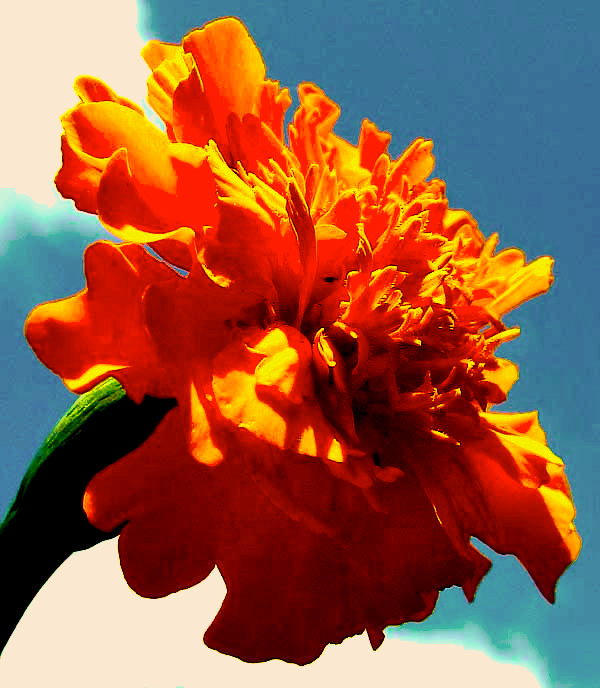
from the September 12, 2010 Newsletter issued from Hacienda Chichen Resort beside Chichén Itzá Ruins, central Yucatán, MÉXICO
MARIGOLDS
I'm enjoying the marigolds planted beside the hut's door. As I sit there reading and looking around, I just can't keep my eyes off their frilly, orangish blossoms, so vivid against dark green foliage behind them or, better yet, against the blue sky beyond. A typical flowerhead with a summery sky beyond is shown above.
Besides drinking in the sheer, gorgeous colors, there are textures and pleasing designs to dwell on. Since we're dealing with composite flowers here, what's shown in the photo is a flowerhead composed of many individual flowers. Marigold flowerheads bear two types of flowers, tubular disk flowers and flat ray flowers. A diagram distinguishing the two types is at www.backyardnature.net/marigold.jpg.
A photo showing a ray flower (on the left) and a disk flower (on the right) on the palm of my hand is shown below:
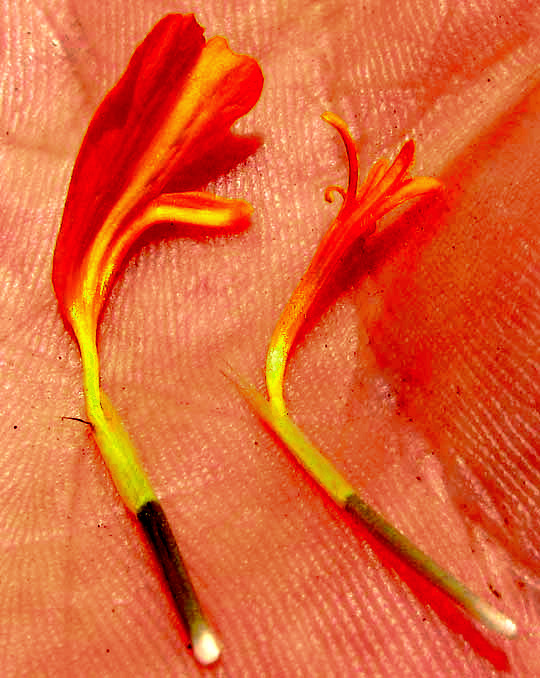
The flowerheads of some Composite Family genera bear only ray flowers (Dandelion and Chicory). Other genera bear only disk flowers (Eupatorium and Ageratum). The flowerheads of Marigolds (as with asters, sunflowers and zinnias) bear both kinds.
The enormous Composite Family embraces maybe 1500-1700 genera and 20,000-25,000 species, and the pollen- producing stamens of the flowers in each of those 20,000-25,000 species do something interesting that people seldom notice because the stamens are so small. You can see what they do in a marigold disk flower below:
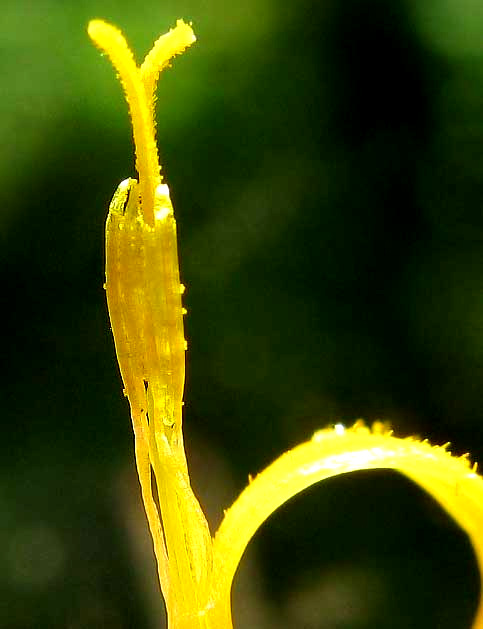
In that picture the disk flower's tubular corolla has been split and pulled to the right. The Y-shaped item at the top is two fuzzy stigmas, which are the female part of the pistil where pollen germinates. The five stamens doing their interesting thing lie just below the projecting stigmas. What they're doing is fusing their anthers into a cylinder surrounding the ovary's style. The style is the "neck" connecting the ovary with its stigmas. Anthers are baglike parts of the stamen that split open to release pollen. Among the thousands of Composite Family species there's mind- boggling variation, yet always the flowers' four or five stamens join at their anthers to form a tube around the style.
A very important feature helping distinguish marigolds from other composite flower types is shown below:
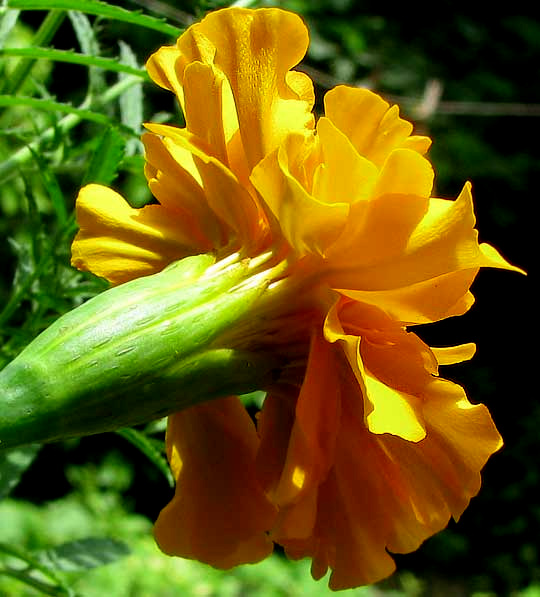
On the left, look at the green, goblet-shaped item from which the disk and ray flowers emerge. That's the involucre. In the vast majority of composite flower types the involucre is composed of two or more series of more or less triangular, sharp-tipped, separate scales or " involucral bracts." You can see that in marigolds the triangular scales are long and slender, there's just one row of them instead of two or more, and they are joined at their margins. A couple of weeks ago we looked at a Zinnia's involucre, which had four or so series of overlapping bracts not joined together at their margins. You can see that again at www.backyardnature.net/n/10/100829zl.jpg.
If you've forgotten what a marigold's pinnately compound leaves with oblong or lanceolate, serrate segments look like, you can see one below:
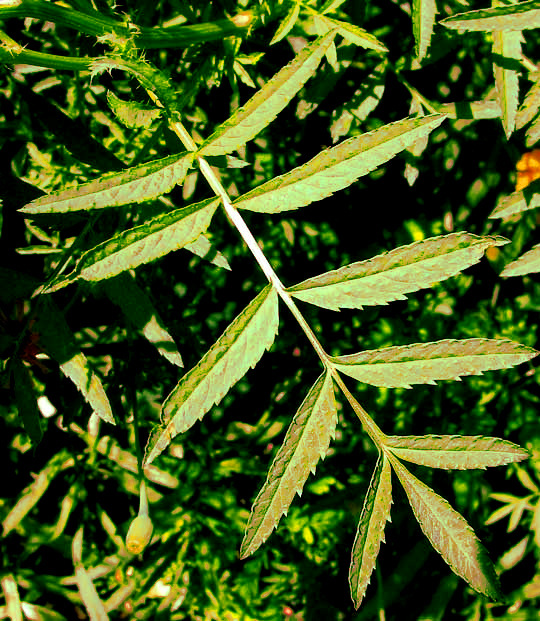
My marigolds, nearly five feet tall (1.5 m), are much larger than those I've seen up North. Their blossoms average about two inches across (5 cm). In garden catalogs this native Mexican species planted worldwide is marketed as the Big, Aztec or African Marigold. It's TAGETES ERECTA. The "African Marigold" name derives from a time when everyone didn't know that it really is from good old Mexico.
from the August 29, 2010 Newsletter issued from Hacienda Chichen Resort beside Chichén Itzá Ruins, central Yucatán, MÉXICO
MARIGOLD GLANDS
In the above picture, maybe you noticed the many little bumps near the marigolds' leaflet edges. A close-up of some leaflets, with backlighting, is below:
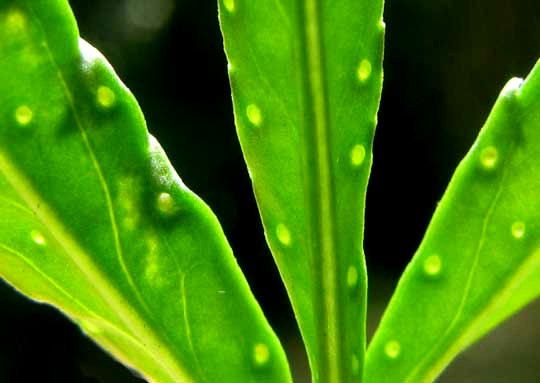
Those are glands filled with oils rich in chemicals that repel certain insects. You've probably read the advice to liberally plant marigolds in your garden to help control pests.
Studies have shown that most marigolds also produce chemical compounds that are toxic or antagonistic to certain harmful nematodes -- and you may remember that my entire tomato crop is being wiped out by nematodes. I don't know if marigold's chemical compounds will control the specific kind of nematode killing my tomatoes, but as soon as I have enough seeds from the marigolds next to my chair I'm going to sow them where now my tomatoes are dying.